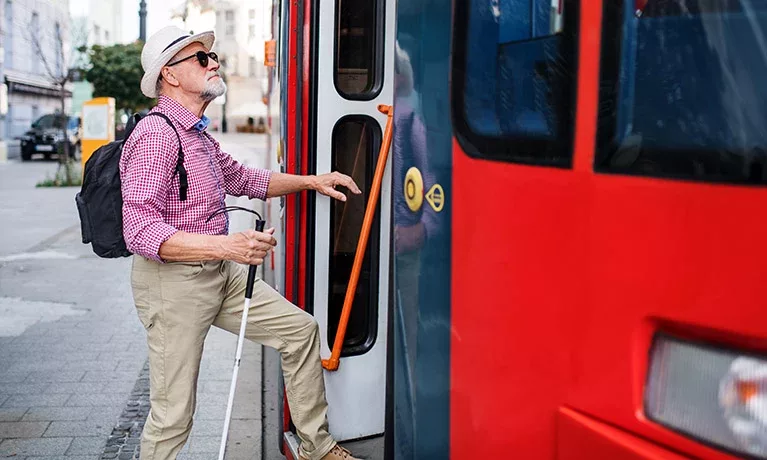Centre for Cities in partnership with TUC Wales has shown how increasing public transport use in Wales will help Welsh Government boost economic growth and reach net zero.
The report says city transport connectivity has become a prominent topic in the UK policy debate in recent years. Public transport has been seen as a lever to promote economic growth and reach net zero, and it was one of the main features of the UK Government’s Levelling Up White Paper.
Wales is no exception, and major transport policy announcements have been made in the last few years. South Wales Metro and the Cardiff Crossrail and Circle tram lines, an integrated transport system in the Cardiff Capital Region, is one of the largest transport infrastructure projects in the UK. And the Welsh Government set out a policy goal to have 45 per cent of all journeys done by public transport and active travel by 2040, a goal that is likely to be important for the economy, for the environment and for access to amenities for those who don’t own a car.
This though has come at a time when Welsh public transport is facing some serious issues. Buses are being cut due to the lower ridership levels and Transport for Wales (TfW) recently announced that pre-pandemic timetabling “just isn’t working”.
This research shows the different roles different parts of Wales will play in increasing public transport usage and the policies required to help make this happen.
The benefits of connectivity towards economic and environmental goals
Transport, both private and public, is critical urban infrastructure. It allows residents to access jobs, essential services, and leisure. A well-functioning transport network will contribute to sustainable economic growth in two ways:
- Promoting economic and productivity growth: better connectivity boosts productivity by matching workers to jobs and jobs to workers (i.e. agglomeration benefits).
- Increasing gains for workers: a comprehensive transport network that increases the job pool available for workers will increase their ability to access different jobs and find a better match to their skills.
Public transport is particularly important also for other aspects:
When congestion reduces the flow of private vehicles and when large shares of people do not own a car – one in five households do not own a car in Wales, and this is higher for the unemployed.
With the environment and health – a good quality public transport network takes cars off the road, reducing air pollution and related sickness and deaths, costing billions of pounds for the NHS and social care.
In relation to place density and accessibility –as an area becomes more densely populated, with more people living around a transport stop, it increases how accessible public transport is and the number of potential customers it can serve.
Patterns of public transport usage in Wales
Driving is the single dominant mode of commuting in Wales, with no sign of a reduction in recent years, and it is followed by walking. Buses are the dominant mode of public transport.
Figure 1: Driving is the single dominant mode of transport in Wales with no signs of usage falling
https://flo.uri.sh/visualisation/15813062/embed?auto=1
Since 2008, rail ridership has been increasing, but this has been dwarfed by the decline in bus use. The decline in local bus ridership started before 2008. It fell by 30.6 per cent between 2004/05 and 2019/20, a fall greater than all other comparator areas. As a result, Wales now has the second lowest levels of bus ridership per capita in the UK.
Figure 2: Bus ridership in Wales following the downward trend of Scotland and English Metropolitan areas
https://flo.uri.sh/visualisation/15818686/embed?auto=1
There are several factors behind the decline of public transport use over such a long period. Despite some local authorities having their own bus operators, bus regulation is likely to have affected Wales negatively. Metrics around fares and the supply of services show the overall weakening of public transport in Wales.
While not as large as the rises seen in other areas of Britain, Wales saw a strong increase in bus fares since the mid-90s.
Fares do not seem to be the only explanatory factor behind the decline in bus ridership. Supply of services is another possible explanation for these differences.
Wales was the region in Great Britain where bus services, measured by the number of kilometres driven by buses, shrunk the most.
Figure 3: Wales is the nation where bus supply declined the most in the last 15 years
https://flo.uri.sh/visualisation/15818867/embed?auto=1
How public transport use differs across Wales and why
Public transport commuting in Wales is similar between its regions, with the exception of Cardiff. The capital is comparatively less reliant on private vehicles (noting they are still the main mode of transport). Within public transport, the role of rail is relatively minor outside the capital. Commuting patterns remained mostly unchanged between 2001 and 2011, except for Cardiff, where there was some substitution from driving to rail and active travel – the share of commuting by bus fell slightly.
Cardiff’s transport constraints differ from those in the remaining Welsh cities.
The capital underperformance seems to be explained by a combination of a relatively small public transport network with lower density in the best-connected areas of the city. Policies designed to boost public transport ridership should focus on expanding the public transport network – connecting more areas to central Cardiff – and densifying well-connected neighbourhoods.
Improving public transport accessibility to the centres of the Swansea, Newport and Wrexham would naturally increase commutes done by public transport. But their economic structure and job concentration will likely limit the increases in ridership as the car continues to hold the edge. This means that a different approach to boosting public transport ridership will be required – one that reflects the lower density nature of both its residents and its jobs.
Table 1: Factors that are constraining different cities and policy implications
| City | Public transport network size | Residential density | Job concentration in central areas | Easy to drive (relative attractiveness of driving) | Summary |
| Cardiff | Seems to be a constraint | Seems to be a constraint | Does not seem to be a constraint | Does not seem to be a constraint | Does not have Reading’s network, nor Brighton /Edinburgh densities. Improving both the network and density is likely to increase public transport outcomes. City centre job density and car congestion suggest there is demand for those improvements. |
| Newport | Does not seem to be a constraint | Seems to be a constraint | Seems to be a constraint | Seems to be a constraint | Improving the public transport accessibility towards the city centre – either by new infrastructure or densification – may bring some gains but they seem to be limited. A public transport model, even with densification, which does not tackle its polycentric nature is unlikely to succeed. |
| Swansea | Seems to be a constraint | Seems to be a constraint | Seems to be a constraint | Seems to be a constraint | |
| Wrexham | Does not seem to be a constraint | Seems to be a constraint | Seems to be a constraint | Seems to be a constraint |
Source: Centre for Cities.
What needs to change?
Putting policies in place that recognise that different parts of Wales have a very different level of potential public transport ridership will be central to the Welsh Government’s ambitions to reduce car usage.
Cardiff should make the largest contribution to incentivising Wales’s use of public and active transport because employment and residents are more concentrated. Policy should focus on:
- Improving public transport provision to its city centre, through bus franchising and public transport investment.
- Build more homes around stations using local development orders.
- Encourage the shift from cars to public transport by using a congestion charge or a workplace parking levy, which in turn raises revenue for public transport improvements.
In Swansea, Newport and Wrexham, as employment is more dispersed, policy should focus on:
- Improving public transport provision to the multiple job hubs in the cities, especially focusing on high-precision, low frequency services that could service edge-of-town business parks to match work patterns.
- Encouraging the expansion of existing job sites, instead of dispersing jobs further, to make public transport easier to provide.
- Introducing a workplace parking levy, as these cities are not greatly impacted by congestion, a workplace parking levy car disincentivise driving and raise revenue for future public transport improvements.
- For Newport, there should also be further integration into the Cardiff City Region by co-ordinating car restricting and revenue raising policies between local authorities, but also bus franchising as part of the Cardiff City Region to improve frequency and capacity of services.
Doing this will require investment and funding. The UK Government has recognised the importance of investing in English cities public transport infrastructure through the City Region Sustainable Transport Settlement, alongside support Greater Manchester with revenue funding for franchising. While Wales’s size mean the magnitude of investment is likely to be lower, improvement will require similar interventions and support from the Welsh Government.






















